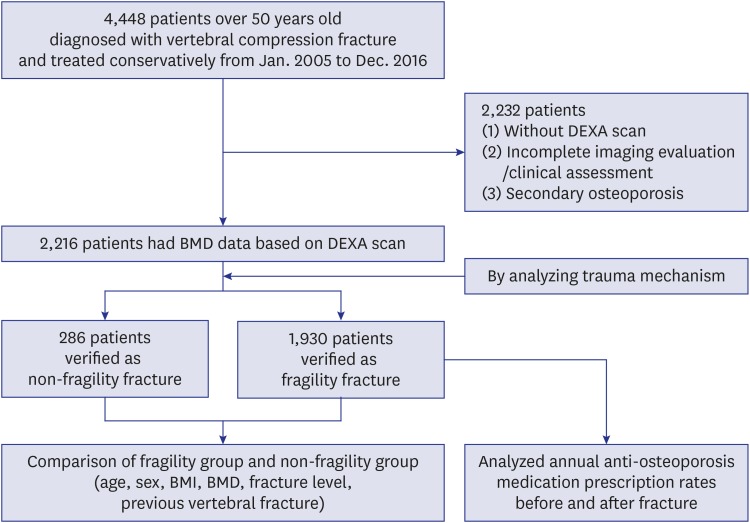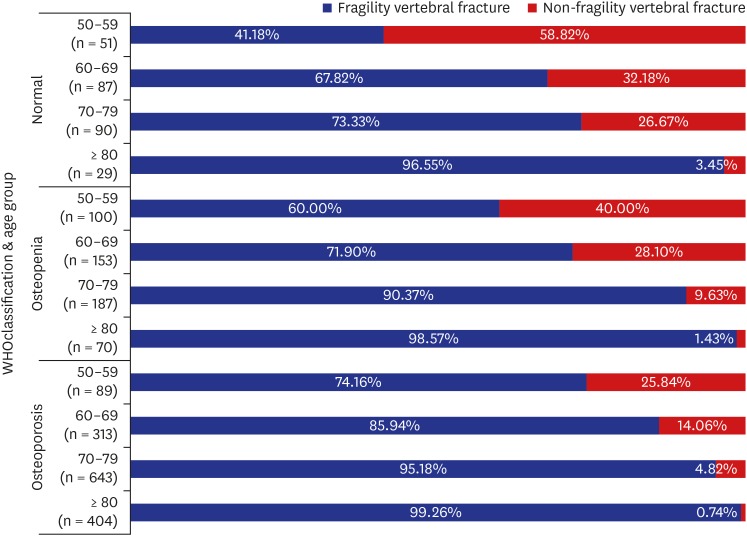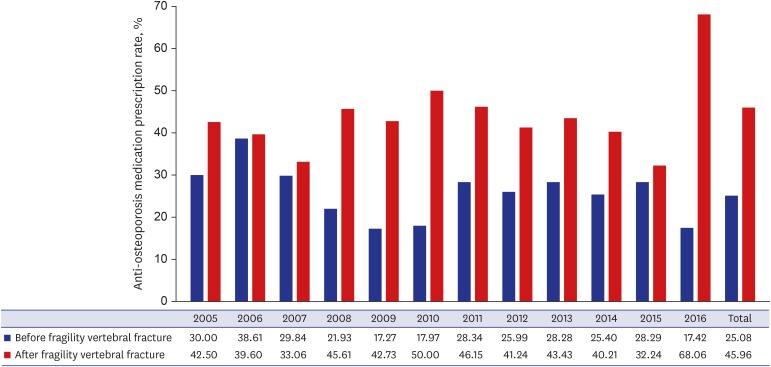Impact of Bone Mineral Density on the Incidence of Age-Related Vertebral Fragility Fracture
- Affiliations
-
- 1Department of Orthopaedic Surgery, Chung-Ang University Hospital, Chung-Ang University College of Medicine, Seoul, Korea
- 2Department of Anesthesiology and Pain Medicine, Chung-Ang University Hospital, Chung-Ang University College of Medicine, Seoul, Korea
- KMID: 2500209
- DOI: http://doi.org/10.3346/jkms.2020.35.e116
Abstract
- Background
Vertebral fragility fracture (VFF) is a common fracture related to osteoporosis. However, VFF might be asymptomatic and often occurs in patients without osteoporosis. Therefore, we investigated the characteristics of age-related VFF and their correlation with bone mineral density (BMD). Furthermore, we analyzed other factors affecting VFF
Methods
Medical records from a single center were retrospectively reviewed for 2,216 patients over 50 years old with vertebral fractures conservatively treated from 2005 to 2016. Patients' age, gender, body mass index (BMI), BMD, fracture level, previous vertebral fractures, and anti-osteoporosis medications were obtained. Patients were divided into fragility/non-fragility groups and age sub-groups. The odds ratio for VFF in relation to BMD was evaluated. We also identified other predictive factors for VFF by age groups.
Results
The fragility group had a higher women ratio, older age, lower BMI, lower BMD, and greater incidence of previous vertebral fractures than the non-fragility group. VFFs were seen in 41.18% of normal BMD patients aged 50–59 and 67.82% of those aged 60–69. The proportion of VFFs increased with age in all WHO osteoporosis classifications. Patients with osteopenia and osteoporosis were 1.57 and 2.62 fold more likely to develop VFFs than normal BMD. In the younger group (under 70), age, women, BMD, and previous vertebral fracture were significant factors affecting VFF, and in the older group (70 and over), age, women, and BMD were factors. In the fragility group, anti-osteoporosis medication rates were 25.08% before and 45.96% after fracture.
Conclusion
Considerable VFFs occurred in the younger age groups without osteoporosis and age itself was another important predictor of VFF especially in older age groups. The discrepancy between the incidence of VFF and BMD suggests the necessity of supplemental screening factors and anti-osteoporosis treatment guidelines using only BMD should be reconsidered.
Keyword
Figure
Cited by 3 articles
-
Fracture Risk and Its Prevention Patterns in Korean Patients with Polymyalgia Rheumatica: a Retrospective Cohort Study
Bora Nam, Yoon-Kyoung Sung, Chan-Bum Choi, Tae-Hwan Kim, Jae-Bum Jun, Sang-Cheol Bae, Dae-Hyun Yoo, Soo-Kyung Cho
J Korean Med Sci. 2021;36(41):e263. doi: 10.3346/jkms.2021.36.e263.Comparison of Denosumab and Zoledronic Acid in Postmenopausal Women With Osteoporosis: Bone Mineral Density (BMD) and Trabecular Bone Score (TBS)
Taewook Kang, Si Young Park, Soon Hyuck Lee, Jong Hoon Park, Seung Woo Suh
J Korean Med Sci. 2022;37(13):e68. doi: 10.3346/jkms.2022.37.e68.The Impact of Persistent Low Weight Status on the Occurrence of Vertebral Fractures: A Nationwide Population-Based Cohort Study
Sang-Min Park, Jiwon Park, Sangsoo Han, Hae-Dong Jang, Jae-Young Hong, Kyungdo Han, Ho-Joong Kim, Jin S. Yeom
J Korean Med Sci. 2023;38(7):e48. doi: 10.3346/jkms.2023.38.e48.
Reference
-
1. United Nations. World population prospects: the 2012 revision. Updated 2013. Accessed May 28, 2019. https://www.un.org/en/development/desa/publications/world-population-prospects-the-2012-revision.html.2. Schousboe JT. Epidemiology of vertebral fractures. J Clin Densitom. 2016; 19(1):8–22. PMID: 26349789.
Article3. Gehlbach SH, Bigelow C, Heimisdottir M, May S, Walker M, Kirkwood JR. Recognition of vertebral fracture in a clinical setting. Osteoporos Int. 2000; 11(7):577–582. PMID: 11069191.
Article4. Choi SH, Kim DY, Koo JW, Lee SG, Jeong SY, Kang CN. Incidence and management trends of osteoporotic vertebral compression fractures in South Korea: a nationwide population-based study. Asian Spine J. 2019.
Article5. Malavolta N, Rossi E, Buffa A, Falchetti A. Fragility fractures: clinical and therapeutic aspects. J Biol Regul Homeost Agents. 2015; 29(4):761–769. PMID: 26753636.6. Friedman SM, Mendelson DA. Epidemiology of fragility fractures. Clin Geriatr Med. 2014; 30(2):175–181. PMID: 24721358.
Article7. Felsenberg D, Silman AJ, Lunt M, Armbrecht G, Ismail AA, Finn JD, et al. Incidence of vertebral fracture in Europe: results from the European Prospective Osteoporosis Study (EPOS). J Bone Miner Res. 2002; 17(4):716–724. PMID: 11918229.
Article8. Boschitsch EP, Durchschlag E, Dimai HP. Age-related prevalence of osteoporosis and fragility fractures: real-world data from an Austrian Menopause and Osteoporosis Clinic. Climacteric. 2017; 20(2):157–163. PMID: 28286986.
Article9. Anderson KB, Holloway-Kew KL, Mohebbi M, Kotowicz MA, Hans D, Pasco JA. Is trabecular bone score less affected by degenerative-changes at the spine than lumbar spine BMD? Arch Osteoporos. 2018; 13(1):127. PMID: 30446835.
Article10. Yusuf AA, Matlon TJ, Grauer A, Barron R, Chandler D, Peng Y. Utilization of osteoporosis medication after a fragility fracture among elderly Medicare beneficiaries. Arch Osteoporos. 2016; 11(1):31. PMID: 27696099.
Article11. World Health Organization. Assessment of fracture risk and its application to screening for postmenopausal osteoporosis. Report of a WHO study group. World Health Organ Tech Rep Ser. 1994; 843:1–129. PMID: 7941614.12. Siris ES, Chen YT, Abbott TA, Barrett-Connor E, Miller PD, Wehren LE, et al. Bone mineral density thresholds for pharmacological intervention to prevent fractures. Arch Intern Med. 2004; 164(10):1108–1112. PMID: 15159268.
Article13. World Health Organization. Guidelines for Preclinical Evaluation and Clinical Trials in Osteoporosis. Geneva: World Health Organization;1998.14. Kanis JA, Kanis JA. WHO Study Group. Assessment of fracture risk and its application to screening for postmenopausal osteoporosis: synopsis of a WHO report. Osteoporos Int. 1994; 4(6):368–381. PMID: 7696835.
Article15. Hans D, Downs RW Jr, Duboeuf F, Greenspan S, Jankowski LG, Kiebzak GM, et al. Skeletal sites for osteoporosis diagnosis: the 2005 ISCD Official Positions. J Clin Densitom. 2006; 9(1):15–21. PMID: 16731427.
Article16. Adult Official Positions of the ISCD. Updated 2019. Accessed January 8, 2020. https://www.iscd.org/official-positions/2019-iscd-official-positions-adult/.17. Vanasse A, Dagenais P, Niyonsenga T, Grégoire JP, Courteau J, Hemiari A. Bone mineral density measurement and osteoporosis treatment after a fragility fracture in older adults: regional variation and determinants of use in Quebec. BMC Musculoskelet Disord. 2005; 6(1):33. PMID: 15969760.
Article18. Palermo A, Tuccinardi D, Defeudis G, Watanabe M, D’Onofrio L, Lauria Pantano A, et al. BMI and BMD: the potential interplay between obesity and bone fragility. Int J Environ Res Public Health. 2016; 13(6):E544. PMID: 27240395.
Article19. Valentinitsch A, Trebeschi S, Kaesmacher J, Lorenz C, Löffler MT, Zimmer C, et al. Opportunistic osteoporosis screening in multi-detector CT images via local classification of textures. Osteoporos Int. 2019; 30(6):1275–1285. PMID: 30830261.
Article20. Cui L, Chen L, Xia W, Jiang Y, Cui L, Huang W, et al. Vertebral fracture in postmenopausal Chinese women: a population-based study. Osteoporos Int. 2017; 28(9):2583–2590. PMID: 28560474.
Article21. Zeng Q, Li N, Wang Q, Feng J, Sun D, Zhang Q, et al. The prevalence of osteoporosis in China, a nationwide, multicenter DXA survey. J Bone Miner Res. 2019; 34(10):1789–1797. PMID: 31067339.
Article22. Delmas PD, van de Langerijt L, Watts NB, Eastell R, Genant H, Grauer A, et al. Underdiagnosis of vertebral fractures is a worldwide problem: the IMPACT study. J Bone Miner Res. 2005; 20(4):557–563. PMID: 15765173.
Article23. Kobayashi T, Kaneko M, Narukawa M. Investigation of the influencing factors on the incidence of vertebral fracture: a meta-analysis based on placebo data of randomized clinical trials. Ther Innov Regul Sci. 2019; 2168479019833657. PMID: 30813778.
Article24. Black DM, Arden NK, Palermo L, Pearson J, Cummings SR. Study of Osteoporotic Fractures Research Group. Prevalent vertebral deformities predict hip fractures and new vertebral deformities but not wrist fractures. J Bone Miner Res. 1999; 14(5):821–828. PMID: 10320531.
Article25. Haczynski J, Jakimiuk A. Vertebral fractures: a hidden problem of osteoporosis. Med Sci Monit. 2001; 7(5):1108–1117. PMID: 11535963.26. Marshall D, Johnell O, Wedel H. Meta-analysis of how well measures of bone mineral density predict occurrence of osteoporotic fractures. BMJ. 1996; 312(7041):1254–1259. PMID: 8634613.
Article27. Kanis JA, Glüer CC. An update on the diagnosis and assessment of osteoporosis with densitometry. Committee of Scientific Advisors, International Osteoporosis Foundation. Osteoporos Int. 2000; 11(3):192–202. PMID: 10824234.
- Full Text Links
- Actions
-
Cited
- CITED
-
- Close
- Share
- Similar articles
-
- Osteoporosis and Osteoporotic Fracture in Premature Menopause
- Type 2 diabetes mellitus and bone fragility: Special focus on bone imaging
- Risk Factors of New Compression Fractures in Adjacent Vertebrae after Percutaneous Vertebroplasty
- What Is the Effect of Spino-Pelvic Sagittal Parameters and Back Muscles on Osteoporotic Vertebral Fracture?
- Clinical aspects and management of osteoporosis and fragility fractures in patients with diabetes





